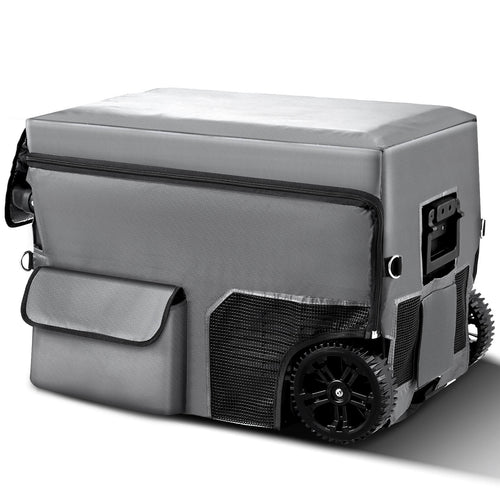Introduction
Portable fridges have become increasingly popular among outdoor enthusiasts, campers, road trip enthusiasts, and even everyday individuals who require reliable cooling on the go. Keeping a portable fridge cold without access to electricity or power can be a challenge, especially when you're on the go or camping in remote locations. However, with a few smart strategies and planning, you can ensure that your food and beverages stay chilled and fresh even without a power source. In this article, we will explore various techniques and tips to keep your portable fridge cold without power.
Preparing for Power Outages
Being prepared for power outages can make a significant difference in keeping your portable fridge cold. Here are some steps you can take:
-
Plan Ahead: If you anticipate a power outage, consider pre-chilling the fridge before you leave home. Plug in the fridge at home or use an external power source to cool it down in advance. This helps create a lower starting temperature, extending the cooling duration when you don't have access to power.
-
Freeze Items: Freeze perishable items, such as meat, poultry, and dairy products, before placing them in the fridge. This will help maintain the overall temperature and extend the cooling duration.
-
Keep the Fridge Full: A full fridge retains cold temperatures better than an empty one. Fill any empty space with bottles of water or ice packs to provide thermal mass and improve insulation.
Utilizing Insulation Techniques
Insulation plays a crucial role in keeping the cold air inside the fridge and preventing heat from entering. Here are some effective insulation techniques:
-
Use Insulating Tools: Wrap the portable fridge with an insulated cooler bag or insulating blankets or towels to provide an extra layer of insulation. This helps minimize heat transfer and maintains the cold temperature for longer.
-
Create a Barrier: Place the fridge in a shaded area and create a barrier around it using items like shade cloth, reflective blankets, or foam boards. This helps shield the fridge from direct sunlight and heat, preserving the internal temperature.
-
Avoid Opening Frequently: Every time you open the fridge, warm air enters, causing the temperature to rise. Minimize opening frequency by organizing the contents effectively and retrieving items only when necessary.

Utilizing Ice Packs and Ice Blocks
Ice packs and ice blocks are effective cooling agents that can help keep your portable fridge cold for an extended period. Here's how you can use them:
-
Pre-Freeze Ice Packs: Pre-freeze ice packs or water bottles and place them inside the fridge. These frozen items act as a cold source, helping maintain the temperature when the power is out.
-
Rotate Ice Packs: If you have access to additional frozen ice packs, rotate them in and out of the fridge to keep the temperature consistently cool.
-
Layer Ice Blocks: If you have access to ice blocks, place them at the bottom of the fridge and layer them with food items. The ice blocks slowly melt, providing a continuous cooling effect.

Utilizing Dry Ice
Dry ice is another excellent option for keeping your portable fridge cold without power. Here are some important considerations when using dry ice:
-
Handle with Care: Dry ice is extremely cold (-78.5 °C or -109.3 °F) and can cause frostbite. Always wear gloves or use tongs when handling it, and never touch it with bare hands.
-
Place Dry Ice on Top: Place the dry ice on top of the items inside the fridge, allowing the cold air to flow downward. This method helps maintain a consistent temperature throughout the fridge.
-
Monitor Ventilation: Dry ice produces carbon dioxide gas as it sublimates. Ensure proper ventilation in the area where the fridge is located to prevent carbon dioxide buildup.
Natural Cooling Methods
When electricity is not available, harnessing natural cooling methods can be a lifesaver.
- Place the fridge in a shaded place: Take advantage of shade by placing your fridge in a cool, shaded area away from direct sunlight. This helps reduce heat absorption and keeps the internal temperature lower.
- Another technique is to utilize natural water sources: Placing the portable fridge in or near a body of water can take advantage of the evaporative cooling effect. The evaporating water helps dissipate heat from the fridge, keeping it cool for an extended period.
- Burying your portable fridge in a shallow hole: If you're camping in a location with suitable soil conditions, consider digging a cold hole. Burying your portable fridge in a shallow hole can utilize the cooler temperature below the ground, helping to maintain a low internal temperature.
Utilizing Solar Power
Solar power can be an eco-friendly and sustainable solution to power your portable fridge when traditional power sources are unavailable. Here's how you can utilize solar power:
-
Invest in a Portable Solar Panel: Purchase a portable solar panel designed for camping or outdoor use. These panels can harness the sun's energy and convert it into electricity to charge your fridge's battery.
-
Position the Solar Panel Correctly: Place the solar panel in direct sunlight and adjust its position throughout the day to maximize sunlight exposure. Ensure there are no obstructions blocking the panel's access to sunlight.

Choosing the Right Portable Fridge
Selecting the right portable fridge is crucial for maximizing cooling efficiency and performance. Consider the following factors:
-
Insulation and Cooling Capabilities: Look for a fridge with excellent insulation properties and efficient cooling capabilities. Features like thick insulation walls and high-quality compressors contribute to better cooling performance.
-
Energy Efficiency: Opt for a portable fridge with energy-efficient features such as low-power modes or adjustable temperature settings. This helps conserve power and prolong the cooling duration.
Maximizing Cooling Efficiency
To maximize cooling efficiency and extend the cooling duration of your portable fridge, follow these tips:
-
Avoid Placing Hot Items: Never place hot or warm items directly into the fridge. Allow them to cool to room temperature or use a separate cooling method before transferring them.
-
Minimize Fridge Movement: Avoid unnecessary movement or shaking of the fridge, as this can disrupt the cooling process and affect the temperature inside.
-
Monitor and Regulate Temperature: Keep a thermometer inside the fridge to monitor the temperature regularly. Adjust the temperature settings as needed to maintain the desired level.

Minimizing Opening Frequency
Opening the portable fridge frequently can cause the internal temperature to rise rapidly. To minimize the need for opening:
-
Organize Contents Strategically: Arrange the items inside the fridge strategically, grouping similar items together. This allows you to retrieve what you need without rummaging through the entire fridge.
-
Plan Ahead: Before opening the fridge, plan what items you need and retrieve them all at once. This reduces the frequency of door openings and helps maintain the cold temperature inside.
Conclusion
Keeping your portable fridge cold without power is achievable with the right techniques and preparation. By implementing insulation methods, utilizing ice packs or dry ice, considering alternative power sources, and choosing the right portable fridge, you can maintain a cool temperature and preserve the quality of your stored items. Remember to plan ahead, minimize opening frequency, and take advantage of shade to optimize cooling efficiency. With these strategies in place, you can enjoy the benefits of a portable fridge even in situations where power is not readily available.
FAQs
FAQ 1: Can I use regular ice instead of ice packs?
Using regular ice is an option, but it may result in a shorter cooling duration compared to reusable ice packs. Regular ice tends to melt faster and can create a mess as it melts. Ice packs are designed to stay colder for longer periods and are more convenient for portable fridges.
FAQ 2: How long can a portable fridge stay cold without power?
The duration a portable fridge can stay cold without power depends on various factors, such as the insulation quality, ambient temperature, and the initial temperature of the contents. In general, a well-insulated portable fridge can keep food cold for several hours to a couple of days, especially if proper cooling techniques and strategies are implemented.
FAQ 3: Can I use frozen water bottles as a cooling method?
Yes, frozen water bottles can serve as both coolants and a source of cold refreshments. They can be placed inside the portable fridge to help maintain the overall temperature. As the water bottles thaw, you can enjoy cold water or drinks, reducing the need for additional ice.
FAQ 4: Are there any special considerations for using a portable fridge in extreme temperatures?
Extreme temperatures, whether hot or cold, can affect the cooling efficiency of a portable fridge. In extremely hot conditions, it's essential to keep the fridge in a shaded area and minimize exposure to direct sunlight. Similarly, in extremely cold conditions, insulating the fridge and avoiding exposure to freezing temperatures will help maintain proper cooling.
FAQ 5: Can I use a portable fridge in my car overnight?
Using a portable fridge in a car overnight is possible, but it's important to consider power consumption and battery drain. If the vehicle's engine is not running, prolonged use of the fridge can drain the car's battery. It's recommended to monitor the battery level or use a dedicated power source, such as a portable power station, to ensure the car's battery doesn't get depleted.







